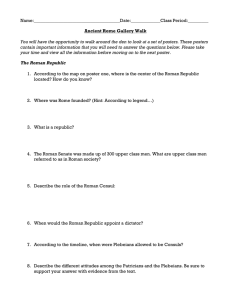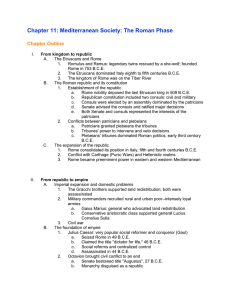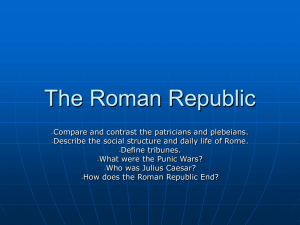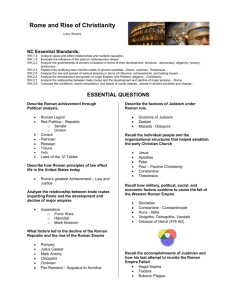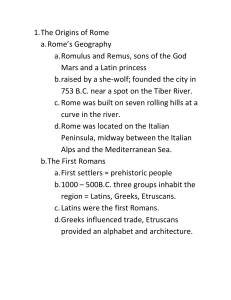Chapter 11: Mediterranean Society: The Roman Phase
advertisement
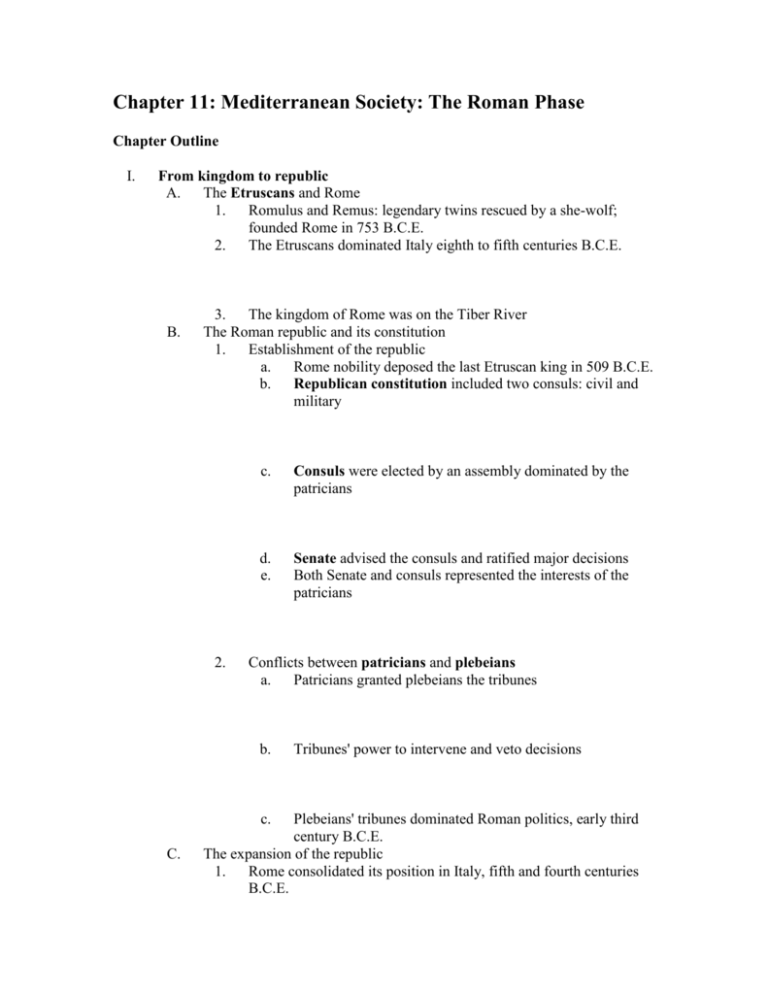
Chapter 11: Mediterranean Society: The Roman Phase Chapter Outline I. From kingdom to republic A. The Etruscans and Rome 1. Romulus and Remus: legendary twins rescued by a she-wolf; founded Rome in 753 B.C.E. 2. The Etruscans dominated Italy eighth to fifth centuries B.C.E. B. 3. The kingdom of Rome was on the Tiber River The Roman republic and its constitution 1. Establishment of the republic a. Rome nobility deposed the last Etruscan king in 509 B.C.E. b. Republican constitution included two consuls: civil and military 2. c. Consuls were elected by an assembly dominated by the patricians d. e. Senate advised the consuls and ratified major decisions Both Senate and consuls represented the interests of the patricians Conflicts between patricians and plebeians a. Patricians granted plebeians the tribunes b. c. C. Tribunes' power to intervene and veto decisions Plebeians' tribunes dominated Roman politics, early third century B.C.E. The expansion of the republic 1. Rome consolidated its position in Italy, fifth and fourth centuries B.C.E. II. 2. Conflict with Carthage (Punic Wars) and Hellenistic realms 3. Rome became preeminent power in eastern and western Mediterranean From republic to empire A. Imperial expansion and domestic problems 1. The Gracchi brothers supported land redistribution; both were assassinated 2. Military commanders recruited rural and urban poor--intensely loyal armies a. Gaius Marius: general who advocated land redistribution b. Conservative aristocratic class supported general Lucius Cornelius Sulla 3. Civil war B. The foundation of empire 1. Julius Caesar: very popular social reformer and conqueror (Gaul) a. Seized Rome in 49 B.C.E. b. Claimed the title "dictator for life," 46 B.C.E. c. Social reforms and centralized control 2. C. d. Assassinated in 44 B.C.E. Octavian brought civil conflict to an end a. Senate bestowed title "Augustus", 27 B.C.E. b. Monarchy disguised as a republic c. Created a new standing army under his control d. The imperial institutions began to take root Continuing expansion and integration of the empire 1. Roman expansion into Mediterranean basin, western Europe, down Nile to Kush 2. Pax romana, Roman Peace, for two and a half centuries III. 3. Well-engineered Roman roads; postal system 4. Roman law--tradition: twelve tables (450 B.C.E.) Economy and society in the Roman Mediterranean A. Trade and urbanization 1. Owners of latifundia focused on specialized production for export 2. Mediterranean trade a. Sea lanes linked ports of the Mediterranean b. Roman navy kept the seas largely free of pirates c. The Mediterranean became a Roman lake 3. The city of Rome a. Wealth of the city fueled its urban development b. c. d. e. B. Statues, pools, fountains, arches, temples, stadiums First use of concrete as construction material Rome attracted numerous immigrants Attractions: baths, pools, gymnasia, circuses, stadiums, amphitheaters Family and society in Roman times 1. The pater familias--eldest male of the family ruled a. Women wielded considerable influence within their families b. Many women supervised family business and wealthy estates 2. Wealth and social change a. Newly rich classes built palatial houses and threw lavish banquets b. Cultivators and urban masses lived at subsistence level c. Poor classes became a serious problem in Rome and other cities d. No urban policy developed, only "bread and circuses" 3. IV. Slavery--one-third of the population a. Spartacus's uprising in 73 B.C.E. b. Urban slaves saw better conditions and possibility of manumission The cosmopolitan Mediterranean A. Greek philosophy and religions of salvation 1. Roman deities: gods, goddesses, and household gods 2. 3. B. Greek influence--Stoicism a. Appealed to Roman intellectuals b. Cicero (106-43 B.C.E.) persuasive orator and writer on Stoicism Religions of salvation gave sense of purpose and promised afterlife a. Roman roads served as highways for religious spread b. Mithraism was popular with Roman soldiers--men only c. Cult of Isis very popular Judaism and early Christianity 1. Monotheistic Jews considered state cults to be blasphemy 2. The Essenes, sect of Judaism; Dead Sea Scrolls 3. Jesus of Nazareth a. Charismatic Jewish teacher, taught devotion to God and love for human beings b. Attracted large crowds through his wisdom and miraculous powers c. The teaching "the kingdom of God is at hand" alarmed the Romans d. Crucifixion in early 30s C.E. e. Became "Christ," or "the anointed one" 4. The New Testament and the Old Testament became the holy book of Christianity 5. Paul of Tarsus was principle figure in spread of Christianity 6. Rapid growth of early Christianity a. Strong appeal to lower classes, urban population, and women b. Became the most influential faith in the Mediterranean by the third century C.E.
